Engine Manual TOYOTA GT86 2014 (in English) Owner's Manual
[x] Cancel search | Manufacturer: TOYOTA, Model Year: 2014, Model line: GT86, Model: TOYOTA GT86 2014Pages: 452, PDF Size: 14.38 MB
Page 186 of 452

186 2-1. Driving procedures
FT86_EE
Manual mode driving
To enter manual mode, shift the shift lever to the M position.
While the upshift/downshift indicator light is illuminated, gears can be
selected by operating the shift lever or paddle shift switches (if
equipped), allowing you to drive in the gear of your choosing.
Even if upshifting operations are performed, if vehicle speed is too low for
the requested gear, the gear will not change.
Upshift indicator
Downshift indicator
Upshifting (+)
Downshifting (-)
Each time the shift lever or pad-
dle shift switches are operated,
the gear changes up or down
one gear and the selected gear,
“1” through “6”, will be set.
The selected gear, from “1” to “6”,
and “M” will be displayed on the
shift position and shift range indi-
cator.
When in manual mode, the gear will not change unless the shift lever
or paddle shift switches are operated.
However, even when in manual mode, the gears will be automatically
changed in the following situations:
When vehicle speed drops (downshift only).
When engine oil temperature is high and engine speed rises close
to the red zone.
Page 188 of 452
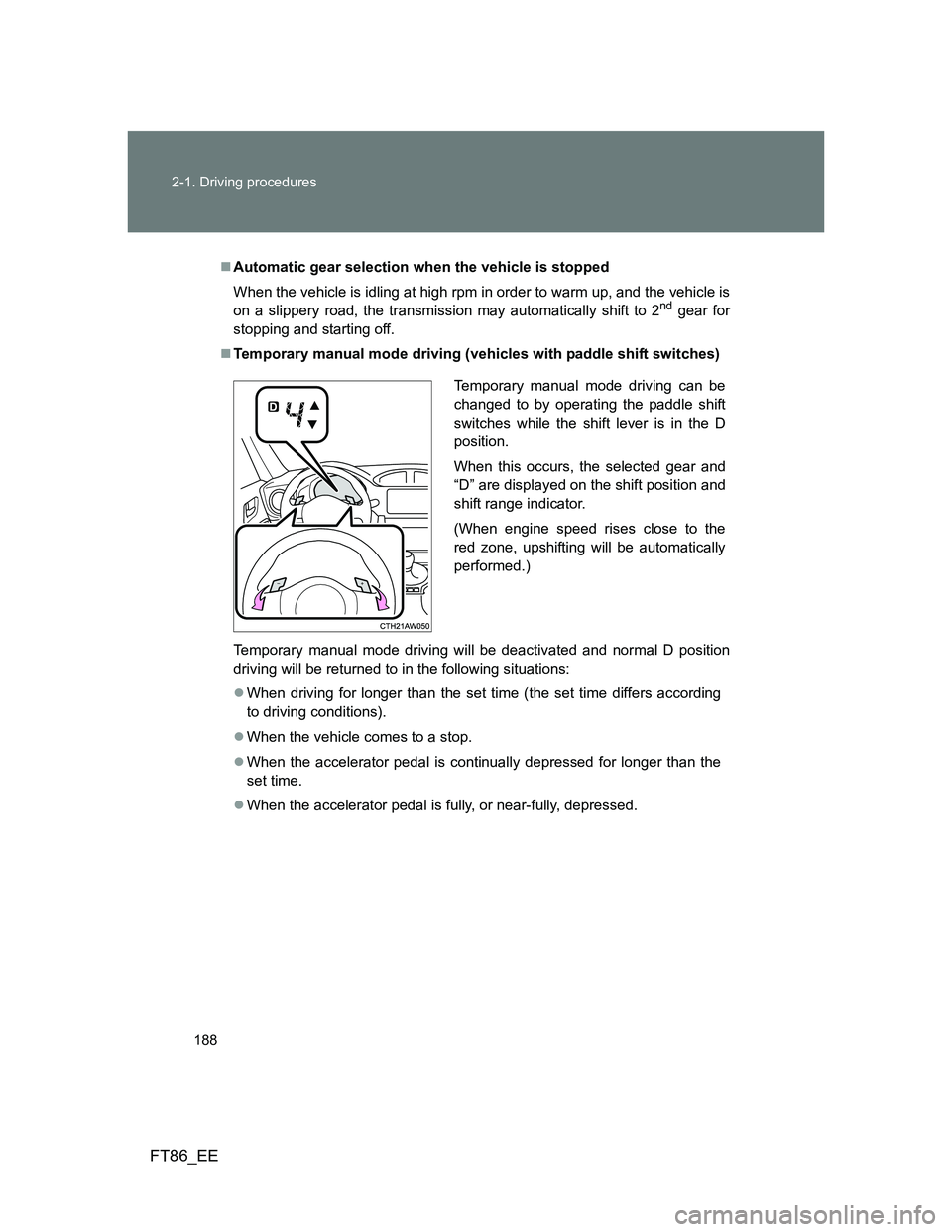
188 2-1. Driving procedures
FT86_EE
Automatic gear selection when the vehicle is stopped
When the vehicle is idling at high rpm in order to warm up, and the vehicle is
on a slippery road, the transmission may automatically shift to 2
nd gear for
stopping and starting off.
Temporary manual mode driving (vehicles with paddle shift switches)
Temporary manual mode driving will be deactivated and normal D position
driving will be returned to in the following situations:
When driving for longer than the set time (the set time differs according
to driving conditions).
When the vehicle comes to a stop.
When the accelerator pedal is continually depressed for longer than the
set time.
When the accelerator pedal is fully, or near-fully, depressed.
Temporary manual mode driving can be
changed to by operating the paddle shift
switches while the shift lever is in the D
position.
When this occurs, the selected gear and
“D” are displayed on the shift position and
shift range indicator.
(When engine speed rises close to the
red zone, upshifting will be automatically
performed.)
Page 198 of 452
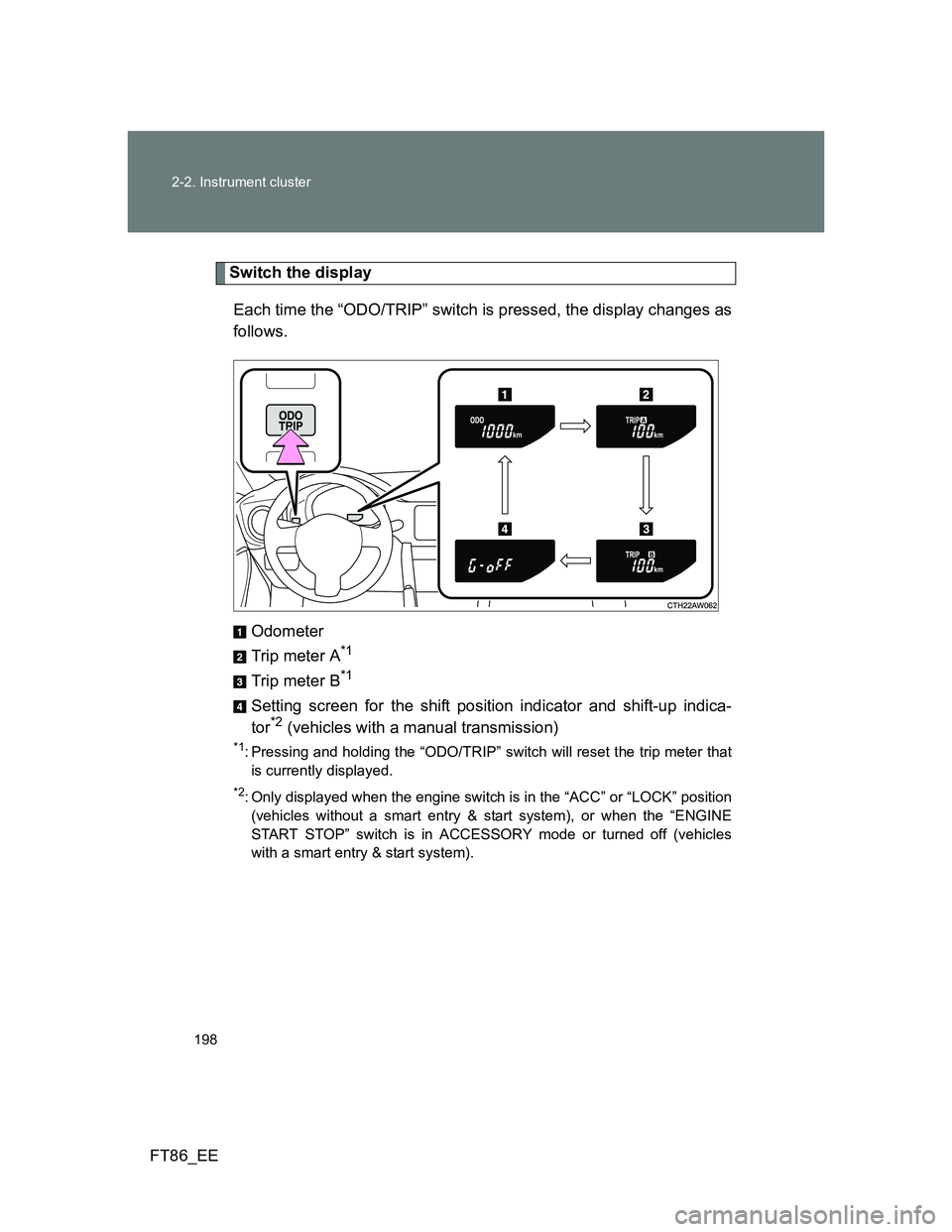
198 2-2. Instrument cluster
FT86_EE
Switch the display
Each time the “ODO/TRIP” switch is pressed, the display changes as
follows.
Odometer
Trip meter A
*1
Trip meter B*1
Setting screen for the shift position indicator and shift-up indica-
tor*2 (vehicles with a manual transmission)
*1: Pressing and holding the “ODO/TRIP” switch will reset the trip meter that
is currently displayed.
*2: Only displayed when the engine switch is in the “ACC” or “LOCK” position
(vehicles without a smart entry & start system), or when the “ENGINE
START STOP” switch is in ACCESSORY mode or turned off (vehicles
with a smart entry & start system).
Page 203 of 452
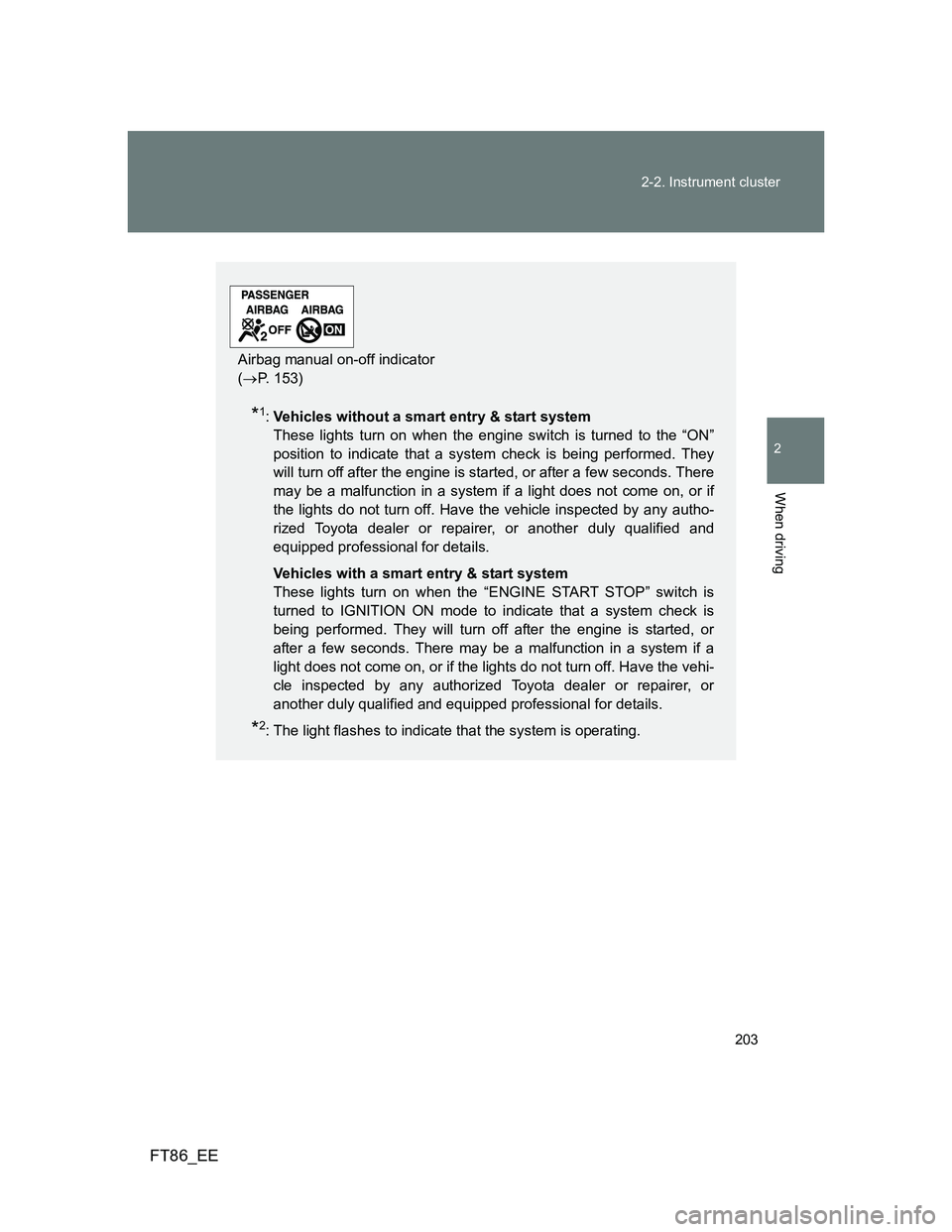
203 2-2. Instrument cluster
2
When driving
FT86_EE
*1:Vehicles without a smart entry & start system
These lights turn on when the engine switch is turned to the “ON”
position to indicate that a system check is being performed. They
will turn off after the engine is started, or after a few seconds. There
may be a malfunction in a system if a light does not come on, or if
the lights do not turn off. Have the vehicle inspected by any autho-
rized Toyota dealer or repairer, or another duly qualified and
equipped professional for details.
Vehicles with a smart entry & start system
These lights turn on when the “ENGINE START STOP” switch is
turned to IGNITION ON mode to indicate that a system check is
being performed. They will turn off after the engine is started, or
after a few seconds. There may be a malfunction in a system if a
light does not come on, or if the lights do not turn off. Have the vehi-
cle inspected by any authorized Toyota dealer or repairer, or
another duly qualified and equipped professional for details.
*2: The light flashes to indicate that the system is operating.
Airbag manual on-off indicator
(P. 153)
Page 211 of 452
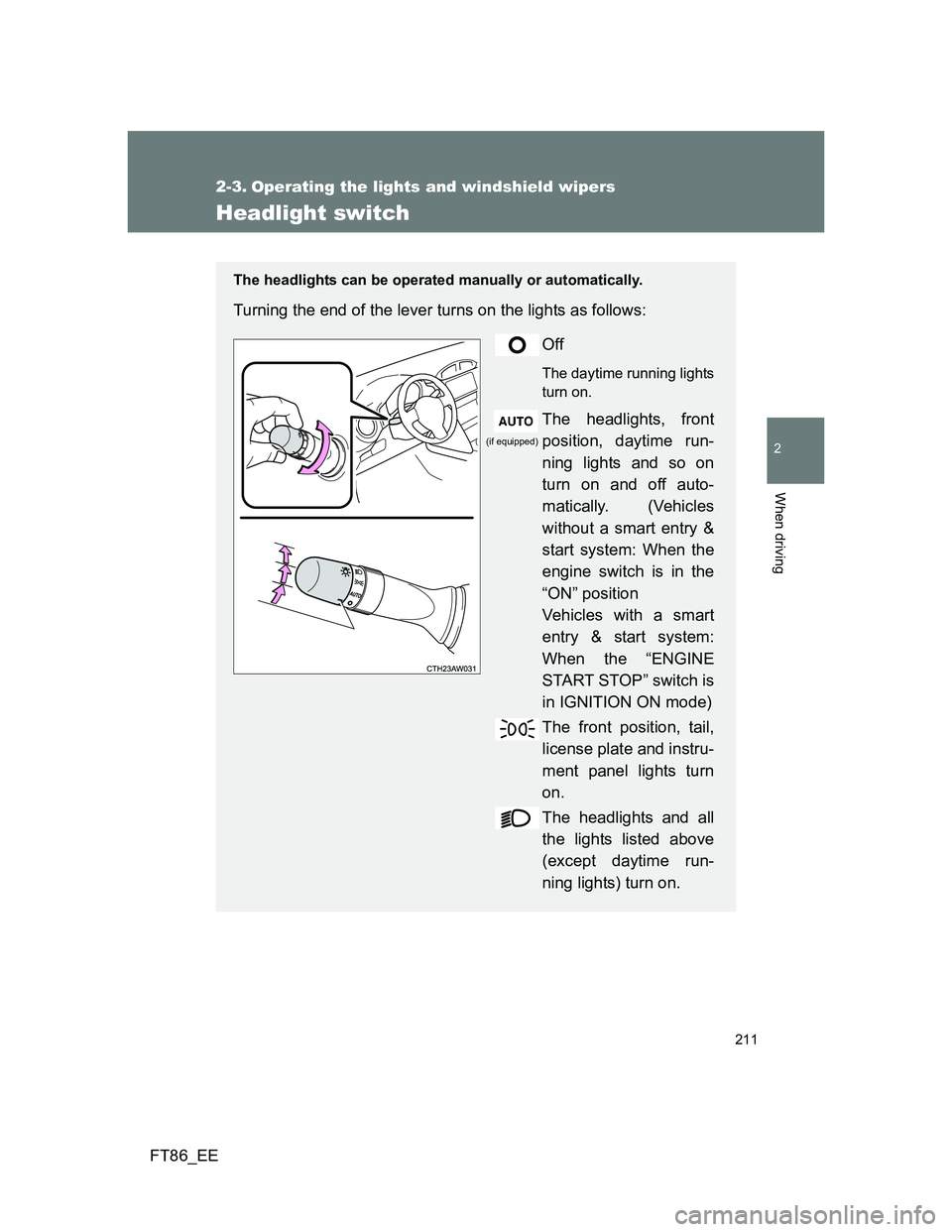
211
2
When driving
FT86_EE
2-3. Operating the lights and windshield wipers
Headlight switch
The headlights can be operated manually or automatically.
Turning the end of the lever turns on the lights as follows:
Off
The daytime running lights
turn on.
The headlights, front
position, daytime run-
ning lights and so on
turn on and off auto-
matically. (Vehicles
without a smart entry &
start system: When the
engine switch is in the
“ON” position
Vehicles with a smart
entry & start system:
When the “ENGINE
START STOP” switch is
in IGNITION ON mode)
The front position, tail,
license plate and instru-
ment panel lights turn
on.
The headlights and all
the lights listed above
(except daytime run-
ning lights) turn on.
(if equipped)
Page 214 of 452
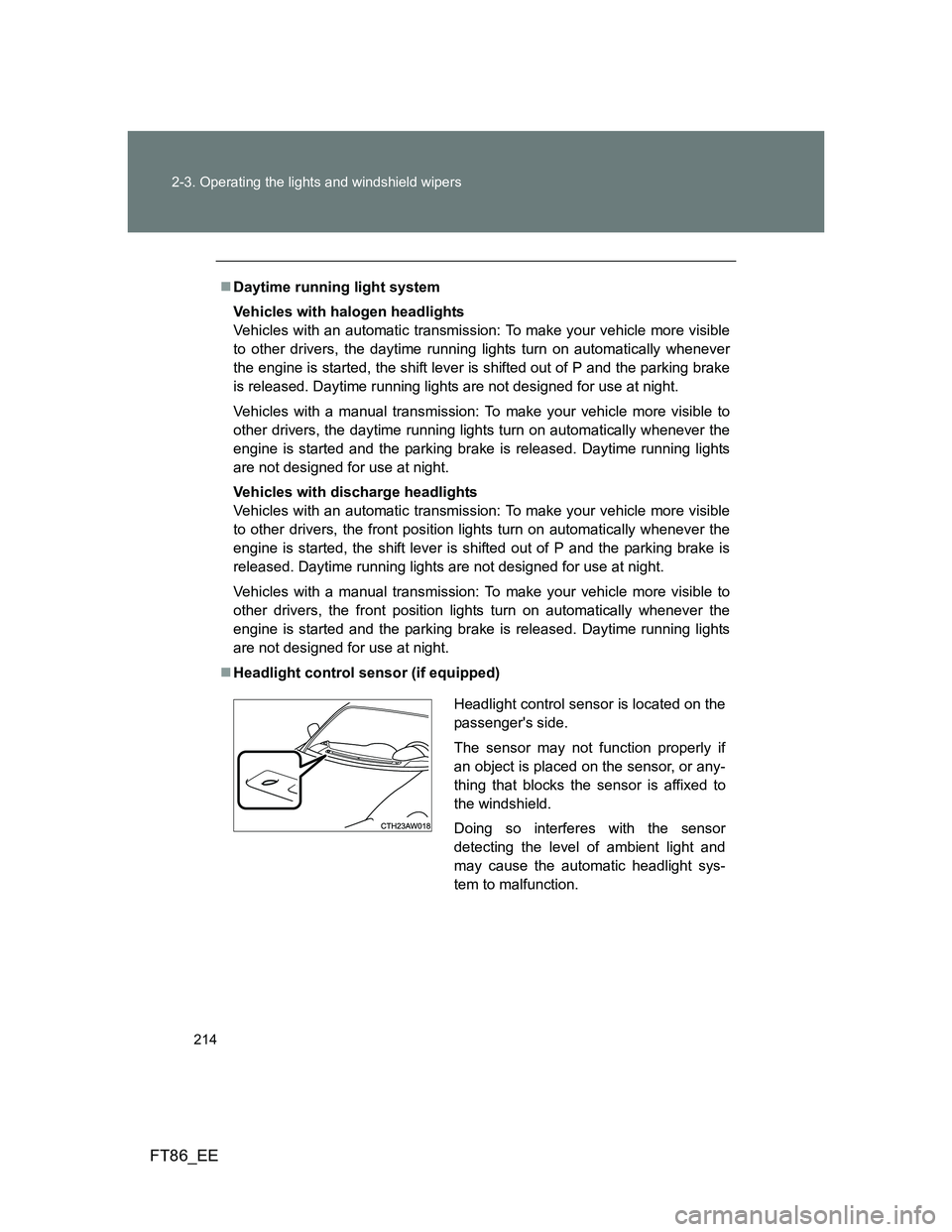
214 2-3. Operating the lights and windshield wipers
FT86_EE
Daytime running light system
Vehicles with halogen headlights
Vehicles with an automatic transmission: To make your vehicle more visible
to other drivers, the daytime running lights turn on automatically whenever
the engine is started, the shift lever is shifted out of P and the parking brake
is released. Daytime running lights are not designed for use at night.
Vehicles with a manual transmission: To make your vehicle more visible to
other drivers, the daytime running lights turn on automatically whenever the
engine is started and the parking brake is released. Daytime running lights
are not designed for use at night.
Vehicles with discharge headlights
Vehicles with an automatic transmission: To make your vehicle more visible
to other drivers, the front position lights turn on automatically whenever the
engine is started, the shift lever is shifted out of P and the parking brake is
released. Daytime running lights are not designed for use at night.
Vehicles with a manual transmission: To make your vehicle more visible to
other drivers, the front position lights turn on automatically whenever the
engine is started and the parking brake is released. Daytime running lights
are not designed for use at night.
Headlight control sensor (if equipped)
Headlight control sensor is located on the
passenger's side.
The sensor may not function properly if
an object is placed on the sensor, or any-
thing that blocks the sensor is affixed to
the windshield.
Doing so interferes with the sensor
detecting the level of ambient light and
may cause the automatic headlight sys-
tem to malfunction.
Page 278 of 452
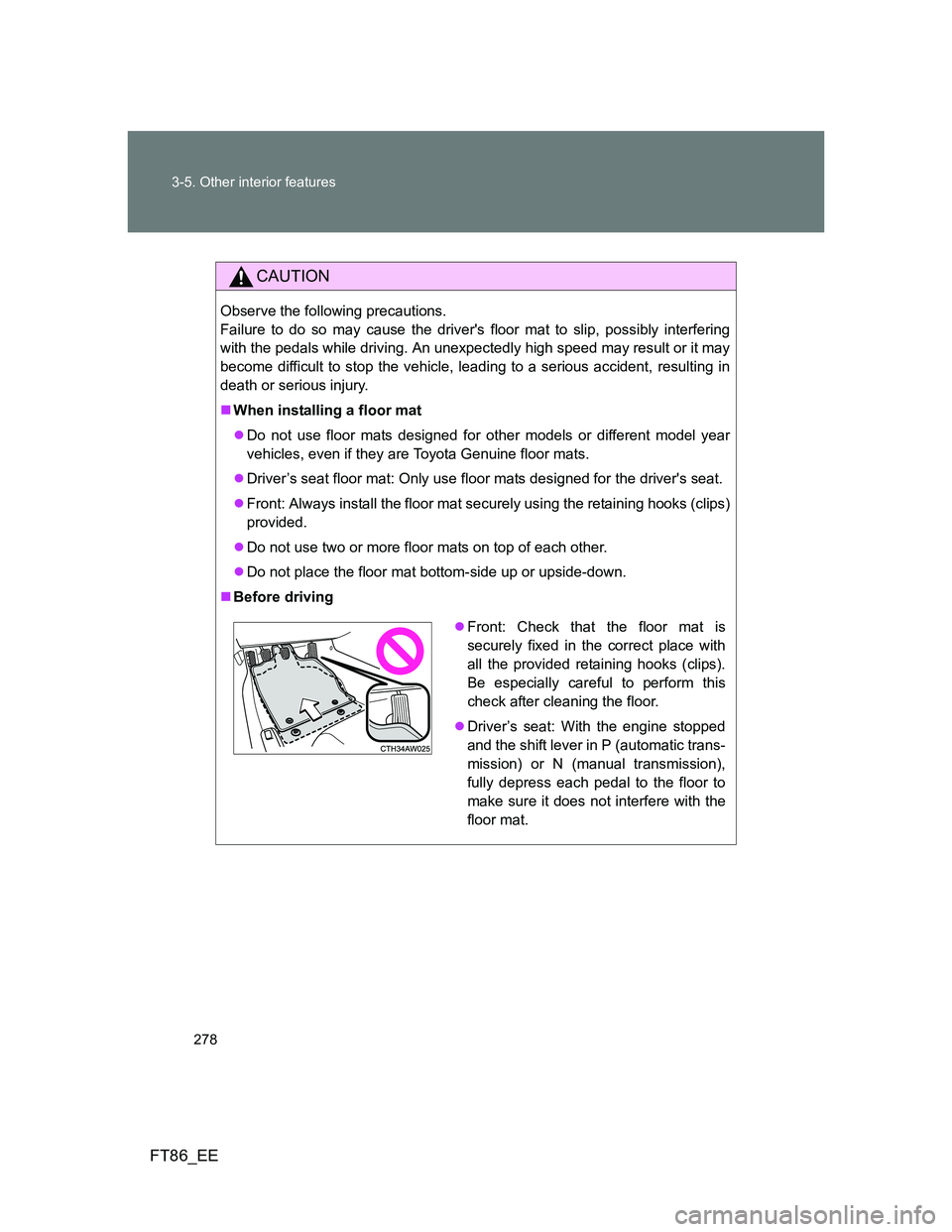
278 3-5. Other interior features
FT86_EE
CAUTION
Observe the following precautions.
Failure to do so may cause the driver's floor mat to slip, possibly interfering
with the pedals while driving. An unexpectedly high speed may result or it may
become difficult to stop the vehicle, leading to a serious accident, resulting in
death or serious injury.
When installing a floor mat
Do not use floor mats designed for other models or different model year
vehicles, even if they are Toyota Genuine floor mats.
Driver’s seat floor mat: Only use floor mats designed for the driver's seat.
Front: Always install the floor mat securely using the retaining hooks (clips)
provided.
Do not use two or more floor mats on top of each other.
Do not place the floor mat bottom-side up or upside-down.
Before driving
Front: Check that the floor mat is
securely fixed in the correct place with
all the provided retaining hooks (clips).
Be especially careful to perform this
check after cleaning the floor.
Driver’s seat: With the engine stopped
and the shift lever in P (automatic trans-
mission) or N (manual transmission),
fully depress each pedal to the floor to
make sure it does not interfere with the
floor mat.
Page 303 of 452
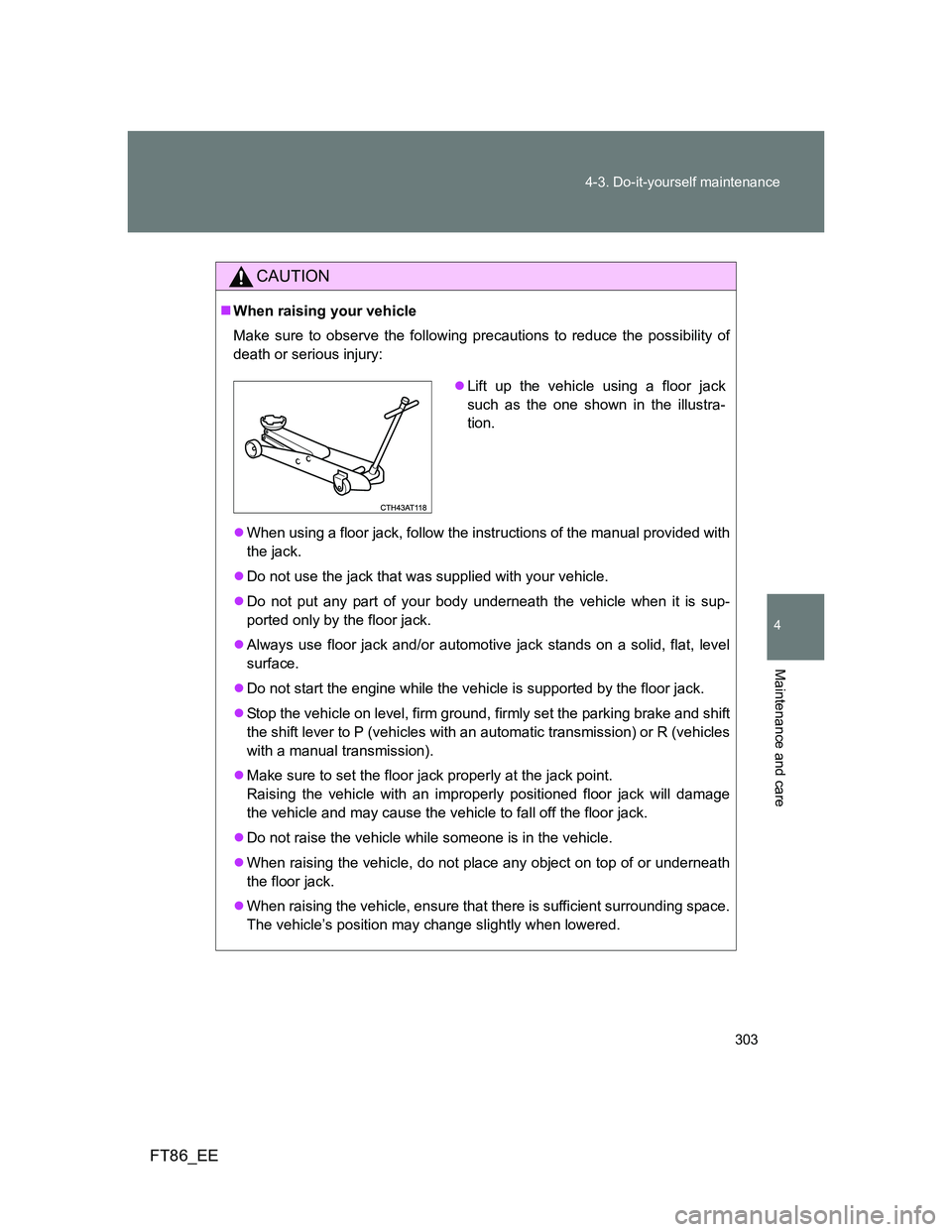
303 4-3. Do-it-yourself maintenance
4
Maintenance and care
FT86_EE
CAUTION
When raising your vehicle
Make sure to observe the following precautions to reduce the possibility of
death or serious injury:
When using a floor jack, follow the instructions of the manual provided with
the jack.
Do not use the jack that was supplied with your vehicle.
Do not put any part of your body underneath the vehicle when it is sup-
ported only by the floor jack.
Always use floor jack and/or automotive jack stands on a solid, flat, level
surface.
Do not start the engine while the vehicle is supported by the floor jack.
Stop the vehicle on level, firm ground, firmly set the parking brake and shift
the shift lever to P (vehicles with an automatic transmission) or R (vehicles
with a manual transmission).
Make sure to set the floor jack properly at the jack point.
Raising the vehicle with an improperly positioned floor jack will damage
the vehicle and may cause the vehicle to fall off the floor jack.
Do not raise the vehicle while someone is in the vehicle.
When raising the vehicle, do not place any object on top of or underneath
the floor jack.
When raising the vehicle, ensure that there is sufficient surrounding space.
The vehicle’s position may change slightly when lowered.
Lift up the vehicle using a floor jack
such as the one shown in the illustra-
tion.
Page 364 of 452
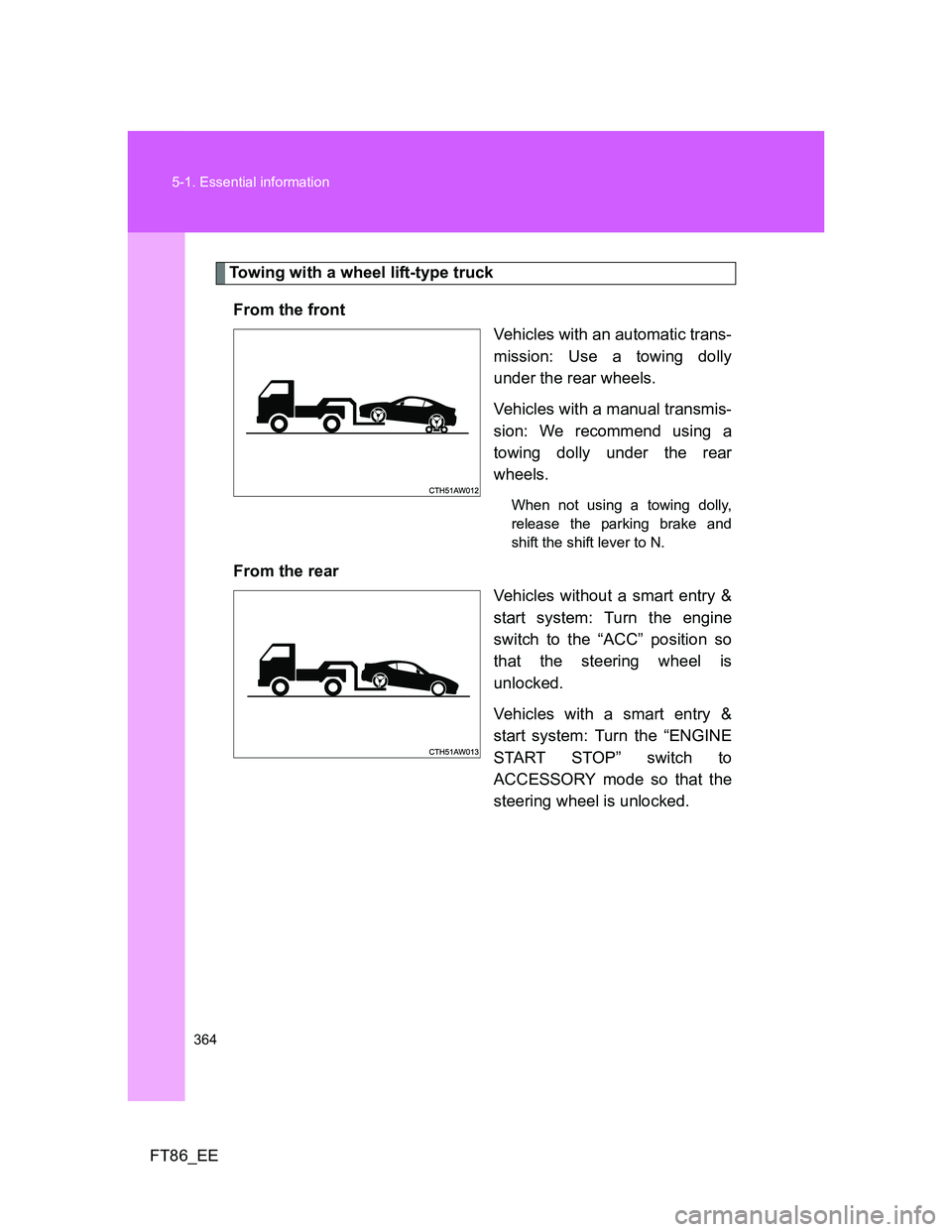
364 5-1. Essential information
FT86_EE
Towing with a wheel lift-type truck
From the front
Vehicles with an automatic trans-
mission: Use a towing dolly
under the rear wheels.
Vehicles with a manual transmis-
sion: We recommend using a
towing dolly under the rear
wheels.
When not using a towing dolly,
release the parking brake and
shift the shift lever to N.
From the rear
Vehicles without a smart entry &
start system: Turn the engine
switch to the “ACC” position so
that the steering wheel is
unlocked.
Vehicles with a smart entry &
start system: Turn the “ENGINE
START STOP” switch to
ACCESSORY mode so that the
steering wheel is unlocked.
Page 374 of 452
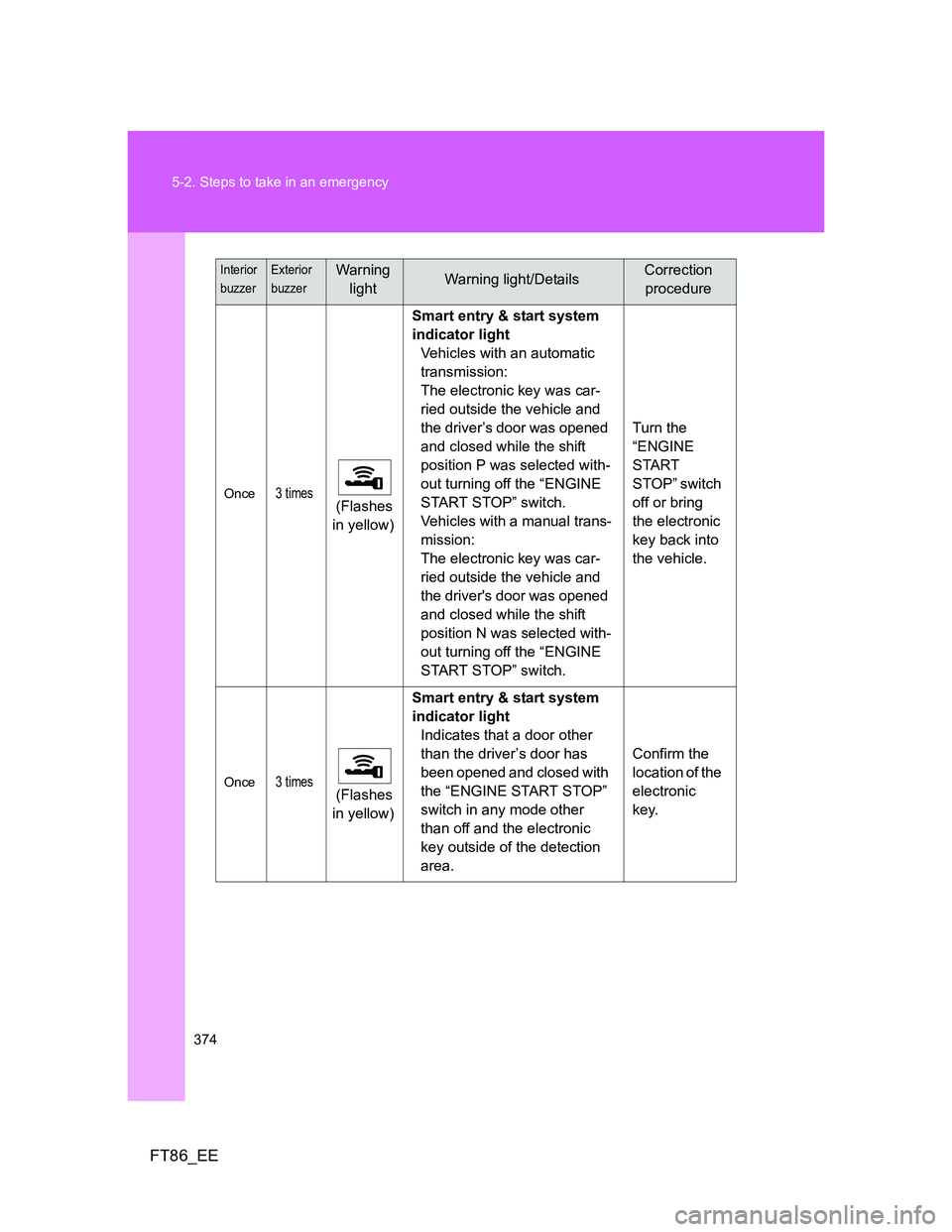
374 5-2. Steps to take in an emergency
FT86_EE
Once3 times (Flashes
in yellow)Smart entry & start system
indicator light
Vehicles with an automatic
transmission:
The electronic key was car-
ried outside the vehicle and
the driver’s door was opened
and closed while the shift
position P was selected with-
out turning off the “ENGINE
START STOP” switch.
Vehicles with a manual trans-
mission:
The electronic key was car-
ried outside the vehicle and
the driver's door was opened
and closed while the shift
position N was selected with-
out turning off the “ENGINE
START STOP” switch.Turn the
“ENGINE
START
STOP” switch
off or bring
the electronic
key back into
the vehicle.
Once3 times (Flashes
in yellow)Smart entry & start system
indicator light
Indicates that a door other
than the driver’s door has
been opened and closed with
the “ENGINE START STOP”
switch in any mode other
than off and the electronic
key outside of the detection
area.Confirm the
location of the
electronic
key.
Interior
buzzerExterior
buzzerWarning
lightWarning light/DetailsCorrection
procedure